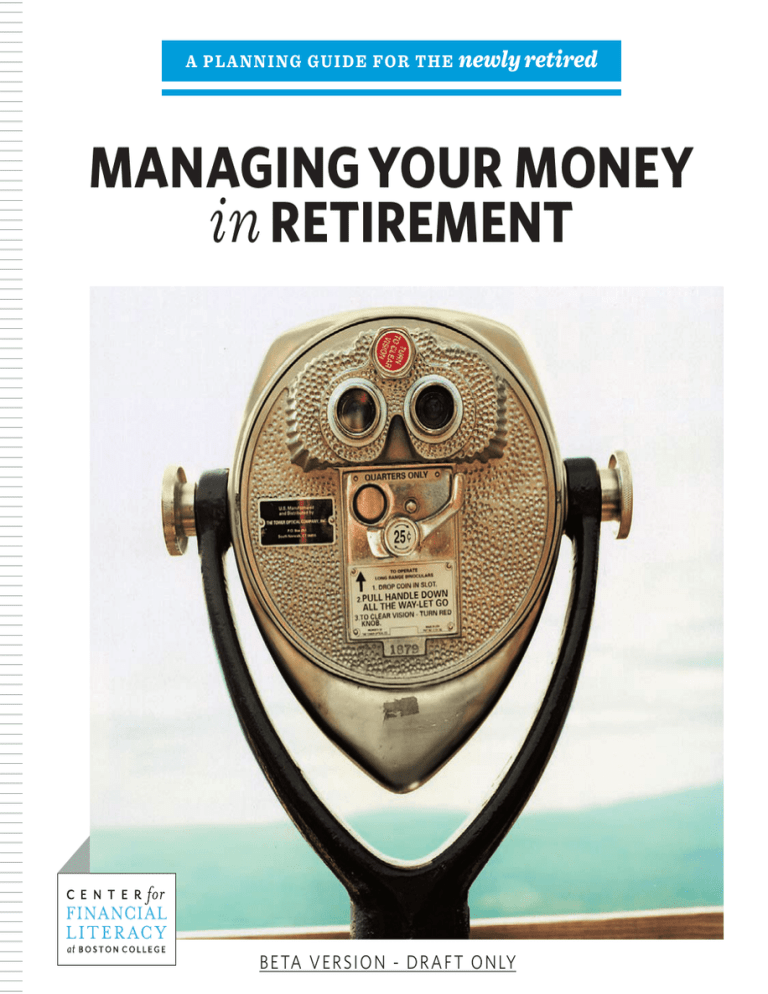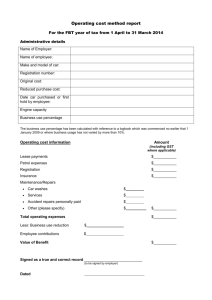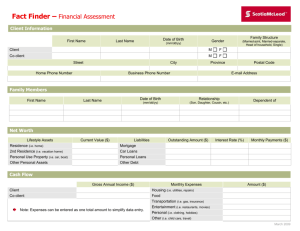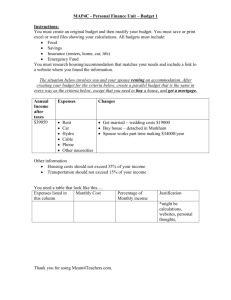
A P L A N N I N G G U I D E FO R T H E
newly retired
MANAGING YOUR MONEY
in RETIREMENT
B E TA V E R S I O N - D R A F T O N LY
A P L A N N I N G G U I D E FO R T H E
newly retired
Managing Your Money
in Retirement
A 3-step process
2 How to see your financial needs are met
What you need
4 Everyday expenses
6 Medical bills
8
10 12 14 What you have
Social Security
Employer pensions
401(k)/IRA savings
Home equity
16 18 19 20 What to do
Lay out a plan that meets your needs
If you don’t have enough
If you do have enough
Do it now
After a lifetime of work, it’s great to take
a trip, help the kids, or get a
new TV. But before you get
what you want, make sure
you have what you need.
By Steven Sass,
Alicia H. Munnell,
Andrew Eschtruth
Art direction and
design by Ronn
Campisi, Ronn
Campisi Design
The mission of
the Center for
Financial Literacy
at Boston College
is to help
Americans make
smart financial
decisions
throughout their
lives. For more
information and our
other products, go to
http://cfl.bc.edu
1
e A 3- STEP PROCESS
How to see your financial
needs are met
1 Define what you need. A reasonable place to begin the retirement
planning process is what you currently need each month to pay the bills. While
spending on trips and entertainment declines with age, rising medical costs
could push your monthly expenses higher.
2 Add up what you have. Social Security and employer pension benefits
can help pay your monthly expenses. Then there’s your savings and your house.
You can draw an income out of these assets, hold them as reserves, or leave
them to your kids or charity.
3 Decide what to do. If you can pay the bills and are well-insured, have
enough assets, or can accept the consequences of a bad medical or financial
shock, you don’t have to do anything. If not, the primary options are to change
the way you use your savings or house, return to work, or tighten your belt.
2
This guide will get you started
Most retirees
can put a
plan together
reasonably
quickly. What’s
important is
to start, and
follow through.
DEFINE WHAT YOU NEED
ADD UP WHAT YOU HAVE
A
It’s not just an
arithmetic problem.
You also need to think
differently about things
flagged by the A on
the following pages.
For more on Curious
Behaviors That
Can Ruin Your
Retirement, go to http://
genuineinteractive.
com/bccfl/curious/
DECIDE WHAT TO DO
3
e WHAT YOU NEED
Everyday
expenses
To stay in your house,
drive the same car,
and remain active
in your community,
you don’t need as
much income as you
did while working.
You pay less tax.
• Y ou don’t pay payroll tax on income from
Social Security, savings, or employer
pensions.
• Y ou don’t pay income tax on all of your
Social Security benefits.
You don’t need to save for retirement.
The mortgage is often paid off, or
will be soon.
You’ll probably spend more on
medical care.
• But this rarely offsets the overall cut in
expenses.
Retirees generally need about 70 percent
of pre-retirement income for everyday
expenses. A surviving spouse needs
about half the couple’s pre-retirement
income.
worksheet
How much do you think you need each month? $
How much for a surviving spouse (if married)? $
a Use today’s dollars. It makes planning much easier.
4
Set a reasonable target
Low-income
households
often need more
than 70% of
what they had
while working.
High-income
households often
need less, as they
see a sharper
cut in taxes and
saving. They
also have more
“discretionary
expenditures”
they could cut,
if need be.
A
It’s tempting to ignore
your needs down
the road. But when
tomorrow comes, your
needs will be there.
5
e WHAT YOU NEED
Medical
bills
Medical care is something you can’t do
without. Medicare pays much of the cost.
But you are responsible for premiums,
deductibles, copays, and items that
Medicare doesn’t cover. Medigap
policies, offered by private insurers,
cover many but not all of these costs.
The big exception is long-term care.
Medical expenses are rising. In
twenty years, your health-care expenses
in today’s dollars, not including longterm care, could triple.
Could you offset this rise in health
care costs with cuts in other expenses?
If not, how much more income would
you or a surviving spouse need?
Health care costs generally
rise over time and as you
age — figure about 6% a
year above inflation.
worksheet
6
Additional monthly income for medical costs in your 80s
$
Long-term care insurance, if you choose to buy it
$
The long-term care dilemma
bb
bb
One in four
Americans age
65 is expected
to spend at least
one year in a
nursing home, at
a cost of about
$75,000 a year
— and this cost
is NOT covered
by Medicare.
Medicaid, the
government
program for the
poor, DOES cover
long-term care
— for those with
very low income
and assets.
You can buy
private long-term
care insurance.
But the cost is
high — about
$200 a month
for a policy
bought at age
65 that pays
up to $60,000
a year.
A
It takes time and effort
to plan. But if you put
it off, you might not be
able to afford the care
you want, or be forced
to deplete the savings
you or your survivor
will need down the road.
7
e WHAT YOU HAVE
Social
Security
For paying everyday expenses, Social
Security benefits are especially valuable.
It’s rarely enough to support your current
lifestyle. But the benefits keep up with
inflation, and the checks keep coming as
long as you live.
Other sources of income tend to dry up
over time. So as you age, Social Security
benefits generally become increasingly
important.
While Social Security has a
shortfall, nearly all proposals
protect the benefits of
people 55 and over.
worksheet
How much you get from Social Security: $
How much your surviving spouse would get (it’s the higher benefit): $
8
Social Security benefits alone are
often inadequate for widow(er)s
Women often
outlive their
husbands by
many years.
They get the
greater of their
own or their
spouse’s monthly
benefit. But it’s:
• Much less than
what they got
as a couple.
• Much less than
the continuing
expenses.
So be sure your
plan protects
your survivor.
A
We’d rather not think
of painful events. But
to protect your loved
ones, it’s sometimes
important you do.
9
e WHAT YOU HAVE
Employer
pensions
Many households entering retirement
So enter how much you and your
today still get a traditional employer
survivor get from employer pensions.
pension, which provides an income that
• The wife is usually the survivor.
• Survivors usually get either nothing or
keeps coming as long as you live.
½ of their spouse’s pension.
Most private employer pensions,
• Inflation could further cut that
however, are not inflation-proof. If prices
benefit.
rise 3 percent a year, in twenty years that
If you have dividends, alimony, rents,
pension benefit will buy barely half what it
or other monthly income, add that as well.
can today.
Then take stock, for now, of what you
need, what you have, and your monthly
shortfall or surplus.
if prices rise 3 percent
a year, what $10,000
could buy:
$10,000
Today
10
$7,400
+10 yrs.
$5,400
+20 yrs.
$4,000
+30 yrs.
Take stock, for now, of your
monthly income and expenses
worksheet
you
your survivor
What you need:
Everyday expenses $
$
More for medical insurance
$
Long-term care insurance? $
total A: $ $
$
What you have:
Social Security $
$
Employer pensions $
$
Other monthly income $
total B: $ $
$
Monthly income shortfall/surplus
Total A minus Total B:
$
$
11
e WHAT YOU HAVE
401(k)/IRA
savings
Now it’s time to make decisions, first
about your savings. Using savings to
finance retirement is hardly straightforward:
How savings are used can increase
risk.
• Using stocks to boost your investment
income comes with the risk that a
downturn will reduce their value.
• The more income you draw out of your
savings, the greater the risk you will
outlive your savings.
Savings have two competing uses:
• You can draw an income out of your
savings to maintain your lifestyle.
• You can hold your savings as reserves, or
These issues are interconnected:
buy insurance, to protect your lifestyle.
• The less your risk – from medical costs,
[note: Another competing use is to leave a
financial shocks, or outliving your
bequest to your children or charities.]
savings – the less reserves you need and
the more income you can draw.
• Long-term care typically comes at the
end of life. So if you hold reserves to
cover the cost of long-term care, you
could use the income those reserves
produce – income above inflation – for
everyday expenses.
12
2 ways to draw a monthly income from
savings earmarked to produce income
$10,000
At 65, for every $10,000 in savings you can
$33
$42
Draw out
about $400 a year
($33 a month) with little
risk that the amount
you draw, adjusted
for inflation, will
ever fall sharply.
Buy an annuity that
pays about $500 a
year ($42 a month),
adjusted for inflation,
as long as either spouse
is alive — but funds
used to buy an annuity
can never be used for
anything else.
A
Preserving principal
and living off the interest might seem like the
only safe bet. But there
are reasonably safe
ways to draw down your
savings over the course
of your life.
13
e WHAT YOU HAVE
Home
equity
Most households entering retirement
own their home, and the equity in their
home – the value of the house less any
remaining mortgage – is often greater
than their 401(k)/IRA savings.
If needed, you can tap home equity to
supplement inadequate incomes or to pay
big medical or nursing home bills.
Widow(er)s often downsize, as they
typically need more income and don’t
need or can’t afford a larger house.
Many needing extended nursing home
care sell their house, which they no
longer need, to pay the bill.
Individuals and surviving
spouses, especially, can use home
equity to pay for long-term care.
14
The most powerful ways
to tap home equity
• Downsizing.
Moving to a
less expensive
house 1) adds to
your retirement
A
Leaving your home and
the memories it holds
is often an emotional
break. But most
retirees who do move
adapt and flourish.
savings; and
2) reduces your
ongoing housing
expense.
Moving is also
easier, physically
and socially,
now than when
you’re older.
• a reverse
mortgage.
A reverse
mortgage is a
new, unfamiliar,
and somewhat
complicated
arrangement.
But it 1) allows
you to stay in
your house
for the rest of
your life; and 2)
provides taxfree income.
15
e WHAT TO DO
Lay out a plan that
meets your needs
The example below illustrates the process.
A couple has a $350 monthly income shortfall, and
projects a $450 shortfall for the survivor, but has a house
worth $170,000 and $65,000 in savings.
• They decide to downsize. After $15,000 in selling and
moving costs, they purchase a condo for $100,000, add
$55,000 to savings, bringing their savings to $120,000.
Downsizing also cuts their housing expenses $200 a
month.
• They decide to use $60,000 of savings for income,
drawing down $200 a month, and hold $60,000 as
reserves.
• This plan results in a $50 monthly surplus and a $50
shortfall for the survivor. The couple plans to cover that
shortfall, along with rising medical costs, from savings
held in reserve and any income those reserves produce.
G The plan maintains the couple’s standard of living – now
and in the future. But they would be hard pressed to pay for
long-term care.
16
Making a plan often means
making a choice for income now
or income in the future.
Monthly Income Shortfall
You +
Spouse
Your
Survivor
-$350
-$450
House
$170,000
$100,000
Savings
$65,000
Downsize
1
$55,000 added to savings
1
1
Housing expenses cut by $200 month
$120,000
1
$60,000 for income >> draw down $200 month
$60,000 as reserves
Shortfall After Plan
You +
Spouse
Your
Survivor
+$50
-$50
17
e WHAT TO DO
If you don’t
have enough
Things to consider
if you can’t pay the
bills or the risks
are too great:
• Tighten your belt. If you adopt a
less costly standard of living today, you
reduce the risk of a much sharper decline
tomorrow, when you’re older, poorer,
and less able to adjust.
• Return to work to conserve
your resources. Jobs can be hard to
find and have less status than jobs you
held in the past. But each year you don’t
touch your savings 1) your savings grow
and 2) your savings won’t have to stretch
as far. So your income from savings
should be about 5-8 percent more.
18
•Change the way you use your
savings or house. Not many retirees
today downsize early in retirement, draw
down their savings, or buy annuities. But
each has advantages that might suit your
needs.
Have a plan should
things go badly
If you need longterm care and
can’t afford a
nursing home, will
you rely on your
family or exhaust
your assets and
go on Medicaid?
If your income
from savings falls
sharply, how might
you reduce your
expenses in the
least painful way?
If you do
have enough
If you can pay the monthly bills for the
rest of your life and are well-insured
or can bear the risks you face, you have
options. You can:
• Spend more freely and buy more things
that you like.
• Give more to charity or your children.
• Invest your surplus savings in stocks
and other assets that are risky, but have
high expected returns. If things go well,
you can spend more, give more, or leave
more to your children. If not, you have
the peace of mind that your needs will
still be met.
19
e WHAT TO DO
Do it
now
What you do makes a difference.
So make a plan:
• Think and act long term, which we don’t
naturally do.
• Plan for your survivor, which means
thinking about death (and making a
will!)
• Assess your risks realistically, and have
a plan if things go badly.
If it’s in your plan:
• Move to a less expensive home.
• Adopt a disciplined drawdown strategy
or buy an annuity – something most
people resist.
• Be prepared to accept less status on the
job.
• Or give up things that you think you
“can’t do without.”
The quicker you act,
the more secure your
retirement will be.
20
http://cfl.bc.edu
For an expanding set of
useful tools and information
http://genuineinteractive.
com/bccfl/curious/
For an entertaining review of “curious
behaviors” that make Managing Your Money
in Retirement so tough
A PLANNING GUIDE FOR THE
newly retired
M A N A G I N G
Y O U R
i n
M O N E Y
R E T I R E M E N T
© 2010, by Trustees of Boston College, Center for Financial Literacy. All rights reserved. Short sections
of text, not to exceed two paragraphs, may be quoted without explicit permission provided that full credit, including copyright notice, is given to Trustees of Boston College, Center for Financial Literacy. The
research reported herein was performed pursuant to a grant
from the U.S. Social Security Administration (SSA) funded
as part of the Financial Literacy Research Consortium. The
opinions and conclusions expressed are solely those of the
authors and do not represent the opinions or policies of SSA,
any agency of the Federal Government, or Boston College.



